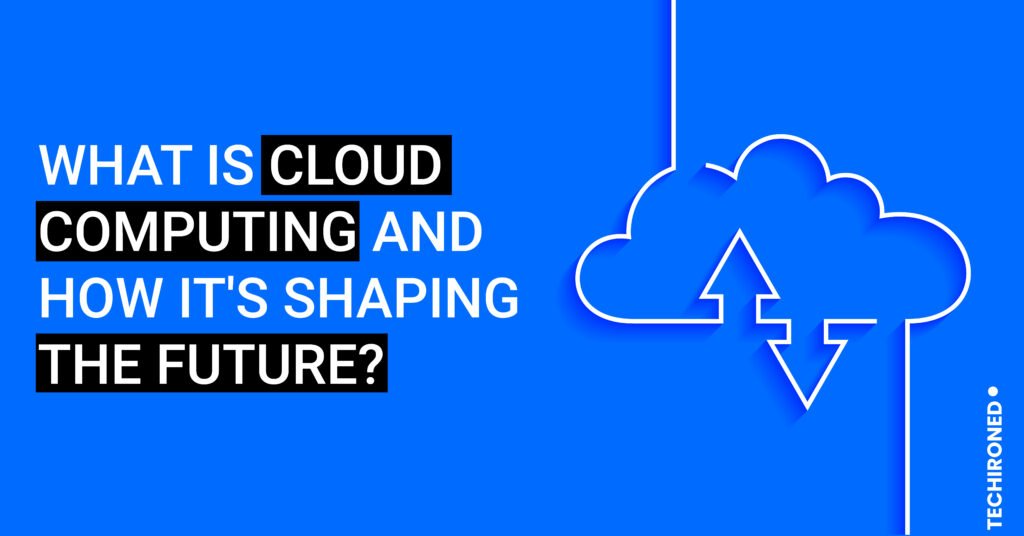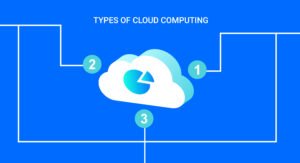Cloud computing, the word you’ve heard the most in this era right? So, let’s find out what is this?
When technology and industry started, people needed many better approaches to store, access, and retrieve data whenever they needed it. Before the computer era, important information was physically stored on paper. But now the information is stored in hard drives of computers and servers. Data can be stored, retrieved, and processed quickly and conveniently from these hard drives and computers.
But the storage capacity of these devices is limited they can perform all the operations on limited resources. Nowadays businesses and technologies are growing at a faster rate and the demand to store a significant amount of data is also increasing with time. This is the point where cloud computing must step in.
If you want to know how it helps in the business then go and read our article.
How Cloud Computing Help Your Business Growth?
What is cloud computing?
The term cloud means the internet. Computing means the systems that empower computers to deal and run with data. Cloud computing means delivering different services through the internet. And these services include databases, software, servers, virtual storage, networking, etc.
Now you do not need to store data on hard drives or servers because cloud computing is providing you services by storing data on the remote database within limited storage. It is providing you with off-site systems that are hosted on the internet to store, process, and retrieve at any time you want.
Cloud computing has become very popular for storage purposes among people who are running businesses on large scale. It has become an important field in Information Technology. The reason for its popularity is it is cost-saving, speed, efficient, performance, security, and increased productivity.
Types of Cloud Computing
Clouds are not of the same type and everyone can’t use one type of cloud. Different types, models, and services have developed according to the needs and to provide different solutions. For implementing cloud services, you need cloud computing architecture or the type of cloud deployment. Cloud services can be deployed in three different ways which are mentioned below.
- Public cloud
In the public cloud, all the computing resources like storage, servers, hardware, and software that are delivered on the internet are handled and controlled by third-party companies. Cloud provider manages and owns all supporting infrastructure, hardware, software, etc. with the public cloud. Through accounts that are accessed by everyone clients can access their services using a web browser.
You can own the public cloud at a lower cloud than both the private and hybrid clouds. Cloud service providers maintain the public cloud, so you do not worry about the maintenance process. It is independent of the location because all services are provided through the internet. As its access is available to everyone, there is no limit to the number of users.
Microsoft Azure is an example of a public cloud.
- Private cloud
In a private cloud, services are used by a single client, organization, or business. The physical location of the private cloud includes the data centers of the company. For hosting their private clouds, a few of the companies pay third-party service providers. All the maintenance of the framework and resources is held on a private network. Private clouds are further divided into two parts depending on location and management.
- On-premises private cloud
- Outsourced private cloud
A private cloud allows effective security and privacy to users. It also offers efficient performance, speed, and space capacity. Organizations do not need to depend on anybody as it is managed by the organization itself that’s why it has full control over the clouds. For those organizations that need separate clouds for their use, this is the best option for them.
- Hybrid cloud
Both public and private clouds combined to make a hybrid cloud. As they are combined by technology together, the information and applications are shared between them. As the data and applications are moving between both clouds, the hybrid cloud provides you greater flexibility and optimizes your security and existing infrastructure.
A hybrid cloud is more secure than a public cloud therefore it is suitable for those organizations that need high security. It delivers all products and services very quickly. It efficiently reduces the risk. Organizations have a choice whether they can keep their data locally or on the cloud if they are using the hybrid cloud.
NASA, Gmail, Google Drive, and Amazon web services are examples of hybrid cloud.
Types of cloud services or cloud service Models
Cloud services are also called stack because they construct on top of each other. These services of the cloud are further split into three types which are given below:
Infrastructure as a service (IaaS)
Platform as a service (PaaS)
Software as a service (SaaS)
- Infrastructure as a service (IaaS)
IaaS is a category in which everything is delivered to the servers from the operating system. It is the basic building block for cloud IT. Users can access, start, and configure the virtual machine and storage as they want because they have the assigned storage. Components such as networking, and security, are provided by infrastructure as a service.
It saves customers from the trouble of maintaining and buying physical servers. In IaaS all the resources are accessible as a service. Its access is GUI and API-based.
Examples are the Digital Ocean, Microsoft Azure, IBM cloud, etc.
- Platform as a service (PaaS)
This platform is delivered through the internet, and it is for creating software. It does not deliver software online. Cloud providers give you a pre-built platform on which you post your code and applications. You do not need to maintain the infrastructure you just have to deal with the applications and codes. This platform includes databases, web servers, and operating systems.
It assists multiple languages and frameworks. As it supports virtualization technology, resources can be scaled according to the need of the organization. It integrates with databases and web services.
Examples of Platform as a service are Heroku, google app engine, etc.
- Software as a service (SaaS)
SaaS delivers services on demand over the internet. That’s why it is also called on-demand software. And these services which include software applications are called web services. In this software, a cloud service provider hosts the applications. They handle the security, maintenance, infrastructure, and software upgradation. You do not need to worry about maintenance and management you just need to know the use of the software. By taking the help of a web browser and internet connection users can access these applications.
It is accessible over the internet and hosted on a remote server. Users do not need to worry about updates. Updates carry out automatically. It is managed from a central location.
Examples of Software as a Service are Dropbox, Slack, Google Apps, Microsoft Office 365, etc.
Benefits of cloud computing
Today businesses are heading to adopt cloud computing because it is offering significant advantages. Some of them are mentioned below.
- Cost
Choosing and buying hardware according to your needs has always been a problem but if it does not suit your requirements you have to deal with it indefinitely. But in cloud computing, you use hardware of hardware and pay for it. You can easily replace it with a better configuration. If it is not according to your requirements. In cloud computing, this is not a big problem. You only pay for the time in which you use it.
- Security
Security is the major concern of every business. Cloud computing provides a highly secure platform to its users that you can access data anywhere at any time. In cloud computing data is saved at different locations and on multiple servers and whenever you add any piece of data it is automatically added to all the copies at various locations. Cloud providers are also responsible for the updates and backup. You do not need to keep the backup anymore you can restore the data whenever you want.
For more security, they also take the benefits of different technologies like two-factor authentication and data encryption. So, now you do not need to worry about security because cloud computing is providing you with a highly secure environment.
- Speed
All the services and IT resources are available from the cloud immediately. Without the dependency on speed, developers can design, software, applications, and architectures and work on new ideas.
- Scalability
Different businesses have different needs for IT. Large businesses will not have the same requirements for resources as small businesses have. So, the demands for resources change according to the need.
Cloud computing is providing you platform to scale your IT department according to your business need. If your business demand is increasing, you can change your storage capacity without investing in physical infrastructure. This helps you in minimizing the operational and storage issue.
How is cloud computing shaping the future?
Today everything is connected to cloud computing digitally. Cloud computing is providing a new world of platforms, services, software, applications, etc. we can see the future of cloud computing in the creation of hybrid IT solutions.
We can’t tell the future of cloud computing, but we can predict it by analyzing the current trends and uses.
- Storage capacity
It has become difficult to store data with security because data is generated in high volume.
Most companies are looking for a platform where they can store their data with high security.
So, now most businesses are taking the opportunity of cloud computing which developed the competition between cloud providers and it’s the prediction that they are providing more data centers at a less price in the future.
- Advanced security
Although cloud computing is providing security but data is not 100% secure. Cloud services that are offered by small companies are not fully secured.
We are hoping in the future that the security will be tight enough to prevent cyber-attacks. As cloud services are integrating with machine learning and artificial intelligence in the future because the cloud will be robust and resilient in the future. Threat detection and prevention will be automated.
- Multi-cloud
Multi-cloud means the integration of two or more cloud services. Different cloud vendors provide this service. The workload is divided among different cloud environments. Sensitive data can be stored by using private clouds.
The main focus of the multi-cloud service is on security, functionality, flexibility, risk mitigation, etc.
According to the reports, Ninety-three percent of enterprises have a multi-cloud strategy.
- Serverless computing
According to reports, serverless computing will be the future of cloud computing by 2025. The demand for it is expected to expand by twenty-five percent from 2021-2026. It is providing ease to companies to run and develop applications without managing physical servers and also provides a secure environment for code testing.
All the scaling, upgrading, and maintenance will be done by the cloud service providers and its prices depend on the use. By using serverless platforms companies can adopt a hybrid model. For all the developers, serverless is a great blessing.
- Modular software
Nowadays, the software which companies are using needs to be modified which results in the fact that modified software should be required by cloud computing with better security, flexibility, and all other features and will be more user-friendly.
This will help a lot of companies in saving their time and money.
Final Words
Today, most organizations and businesses are migrating toward cloud computing for high security, flexibility, efficient speed, performance, scalability, storage, and various other purposes. Cloud providers are also focusing on meeting the needs of their customers as seventy-five percent of the population of IT is expected to shift to clouds. They are providing opportunities for their users to switch their applications easily according to their needs and pay for the used resources only.
As most businesses looking for innovative ways to fulfill their business goals, cloud providers are working on providing powerful and cost-effective platforms for them in the future. Cloud computing will play a vital role in shaping the future of technology and this growth of it can be assigned to appearing technologies like Artificial Intelligence, edge computing, etc.



